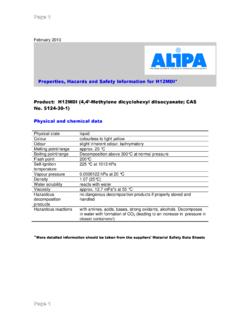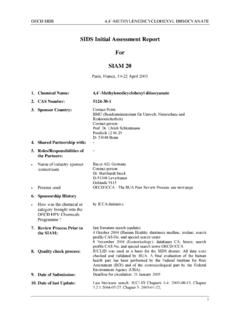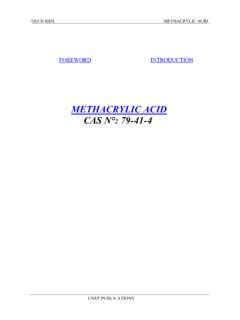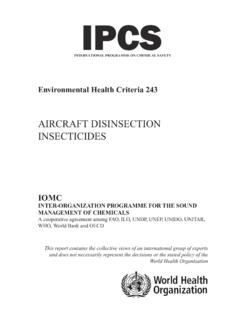Transcription of Hexane, 1,6-diisocyanato-, homopolymer, Me Et …
1 Hexane, 1,6-diisocyanato-, homopolymer, me et ketone oxime -blocked October 2012 Endpoint Summary Information Hexane, 1,6-diisocyanato-, homopolymer, me et ketone oxime -blocked EC Number: 617-779-3 CAS Number: 85940-94-9 IUCLID Endpoint Summary Information The information compiled in this document consists mainly of the IUCLID endpoint summaries regarding environmental and health hazards and the rationale for DNEL and PNEC derivation. This information is included in the REACH registration dossier for Hexane, 1,6-diisocyanato-, homopolymer, me et ketone oxime -blocked but is currently not disseminated on the ECHA website.
2 However, this information is deemed necessary to comprehend the conclusions as derived in the REACH registration dossier for Hexane, 1,6-diisocyanato-, homopolymer, me et ketone oxime -blocked. Hexane, 1,6-diisocyanato-, homopolymer, me et ketone oxime -blocked October 2012 Endpoint Summary Information Page 2 / 33 Table of Contents 1. PHYSICAL AND CHEMICAL PROPERTIES .. 4 2. ENVIRONMENTAL FATE PROPERTIES .. 5 Hydrolysis .. 5 Phototransformation in air .. 6 Biodegradation .. 6 Biodegradation in water .. 6 Biodegradation in soil .. 6 Summary and discussion of degradation.
3 6 Environmental distribution .. 7 Adsorption/desorption .. 7 Volatilisation .. 7 Bioaccumulation .. 7 Secondary poisoning .. 7 3. ENVIRONMENTAL HAZARD ASSESSMENT .. 8 Aquatic compartment (including sediment) .. 8 Toxicity test results .. 8 Short-term toxicity to fish .. 8 Long-term toxicity to fish .. 9 Short-term toxicity to aquatic invertebrates .. 9 Long-term toxicity to aquatic invertebrates .. 10 Algae and aquatic plants .. 10 Sediment organisms .. 11 Calculation of Predicted No Effect Concentration (PNEC) .. 11 Terrestrial compartment .. 12 Toxicity to soil macro-organisms .. 12 Toxicity to terrestrial plants.
4 12 Toxicity to soil micro-organisms .. 12 Calculation of Predicted No Effect Concentration (PNEC soil) .. 13 Atmospheric compartment .. 13 Microbiological activity in sewage treatment systems .. 13 Toxicity to aquatic micro-organisms .. 13 PNEC for sewage treatment plant .. 13 Non compartment specific effects relevant for the food chain (secondary poisoning) .. 14 Toxicity to birds .. 14 Toxicity to mammals .. 14 Calculation of PNEC oral (secondary poisoning) .. 14 Conclusion on the environmental hazard assessment and on classification and labelling .. 14 4. HUMAN HEALTH HAZARD ASSESSMENT .. 15 Toxicokinetics (absorption, metabolism, distribution and elimination).
5 15 Acute 15 Irritation .. 16 Sensitisation .. 18 Repeated dose toxicity .. 18 Mutagenicity .. 19 Carcinogenicity .. 20 Toxicity for reproduction .. 20 Effects on fertility .. 20 Developmental toxicity .. 20 Summary and discussion of reproductive toxicity .. 21 Derivation of DNEL(s) / DMEL(s) .. 22 5. HUMAN HEALTH HAZARD ASSESSMENT OF PHYSICO-CHEMICAL PROPERTIES .. 28 Explosivity .. 28 Flammability .. 28 Oxidising potential .. 29 Hexane, 1,6-diisocyanato-, homopolymer, me et ketone oxime -blocked October 2012 Endpoint Summary Information Page 3 / 33 6.
6 PBT AND VPVB ASSESSMENT .. 29 Assessment of PBT/vPvB Properties .. 29 Persistence assessment (P and vP) .. 30 Bioaccumulation assessment (B and vB) .. 30 Toxicity assessment (T) .. 30 Summary and overall conclusions on PBT or vPvB properties .. 30 Emission Characterisation .. 31 7. REFERENCES .. 32 Hexane, 1,6-diisocyanato-, homopolymer, me et ketone oxime -blocked October 2012 Endpoint Summary Information Page 4 / 33 1. PHYSICAL AND CHEMICAL PROPERTIES Molecular weight range: Not applicable (UVCB substance) Molecular formula: Not applicable (UVCB substance) Appearance/physical state/colour: liquid /viscous/ not reported Melting / freezing point : No melting/freezing point is available.
7 A glass transition was observed at -3 C. Boiling point: The study does not need to be conducted as the registered substance undergoes thermal decomposition before boiling. Relative density: g/cm3 at 20 C Vapour pressure: 1 x 10-3 Pa at 20 C. Water solubility: mg/L at 20 C (slightly soluble in water) Partition coefficient n-octanol/water (log value): Flash point: 144 C Flammability: not flammable Explosive properties: non explosive Self-ignition temperature: - Oxidising properties: no Stability in organic solvents: stable Dissociation constant: - Viscosity: 4960 (+/- 248) at 20 C and 823 (+/- 41) at 40 C. Thermal stability: the substance exhibits thermal decomposition at heating temperature above 90 C.
8 Hexane, 1,6-diisocyanato-, homopolymer, me et ketone oxime -blocked October 2012 Endpoint Summary Information Page 5 / 33 2. ENVIRONMENTAL FATE PROPERTIES General discussion of environmental fate and pathways: Justification for the non-equivalence of the test material to the submission substance identity HDI trimer MEKO blocked is always produced and marketed as dissolved in solvent. Thus, the substance is reasonably expected to be handled and used in a form of a mixture of the registered substance in the solvent. The environment is anticipated to be exposed rather to the mixture than to the pure substance.
9 Thus, the testing strategy was designed to take this route of exposure into account and it has been concluded that testing the mixture was more relevant than testing the registered substance as such. To conclude, environmental fate studies were performed on the mixture and as a consequence for endpoint study records, the test material is not ticked when requesting if equivalent to submission substance identity. Summary of available data Considering the type of substance (UVCB) and according to manufactures experience, the registered substance is to be considered as difficult to analyse. In addition, the test material (being the mixture of the registered substance in the solvent) exhibits low water solubility (less than 100 mg/L).
10 The test material has to be considered as a difficult mixture to be tested particularly for achieving exposure concentration and preparing representative media. In a hydrolysis study (OECD TG 111), a half-life of 139 d for pH 7 at 25 C in water was calculated for the registered substance (HDI Trimer MEKO-blocked) from experimental data obtained at 50, 65 and 80 C. Considering the nature of the substance (UVCB), it was not possible to identify the hydrolysis product. Therefore, the registered substance is to be considered as stable to hydrolysis based on the available half-life. In a standard screening biodegradation test (manometric respirometry method), the percentage of biodegradation of test material was determined at 3, 4, 7 and 9% based on BOD after 6, 12, 20 and 28 days of exposure, respectively.












